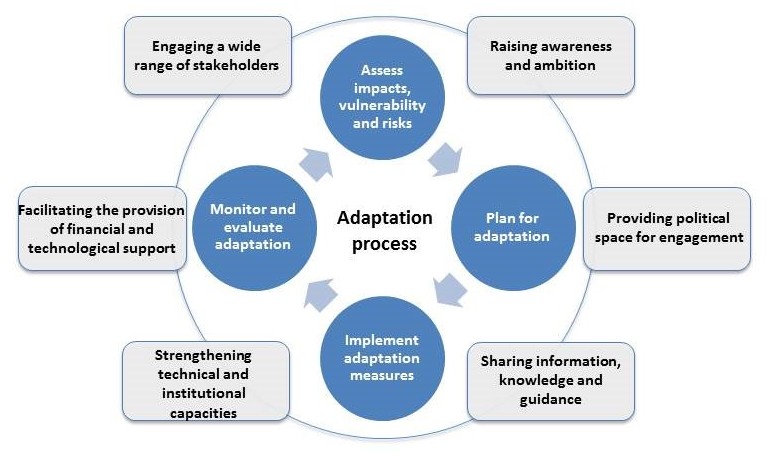What do adaptation to climate change and climate resilience mean?


The world is already experiencing changes in average temperature, shifts in the seasons and an increasing frequency of extreme weather events and other climate change impacts and slow onset events. The faster the climate changes, and the longer adaptation efforts are put off, the more difficult and expensive it could be.
Adaptation refers to adjustments in ecological, social, or economic systems in response to actual or expected climatic stimuli and their effects or impacts. It refers to changes in processes, practices, and structures to moderate potential damages or to benefit from opportunities associated with climate change. In simple terms, countries and communities need to develop adaptation solution and implement action to respond to the impacts of climate change that are already happening, as well as prepare for future impacts.
Adaptation solutions take many shapes and forms, depending on the unique context of a community, business, organization, country or region. There is no ‘one-size-fits-all-solution’—adaptation can range from building flood defences, setting up early warning systems for cyclones and switching to drought-resistant crops, to redesigning communication systems, business operations and government policies. Many nations and communities are already taking steps to build resilient societies and economies, but considerably greater action and ambition will be needed to cost-effectively manage the risks, both now and in the future.
Successful adaptation not only depends on governments but also on the active and sustained engagement of stakeholders including national, regional, multilateral and international organizations, the public and private sectors, civil society and other relevant stakeholders, as well as effective management of knowledge. Adaptation to the impacts of climate change may be undertaken across various regions, and sectors, and at various levels.
Parties to the UNFCCC and its Paris Agreement recognize that adaptation is a global challenge faced by all with local, subnational, national, regional and international dimensions. It is a key component of the long-term global response to climate change to protect people, livelihoods and ecosystems. Parties acknowledge that adaptation action should follow a country-driven, gender-responsive, participatory and fully transparent approach, considering vulnerable groups, communities and ecosystems, and should be based on and guided by the best available science and, as appropriate, traditional knowledge, knowledge of indigenous peoples and local knowledge systems, with a view to integrating adaptation into relevant socioeconomic and environmental policies and actions.
How do parties address adaptation?
The figure above shows graphically the adaptation cycle under the UN climate change regime, including four general components, which are individually featured under the SPOTLIGHT section (at the bottom of this page).
Within the UN climate change regime, Parties carry out adaptation-related activities in a number of workstreams, through work programmes and in specialized groups and committees. These include:
In 2001, at COP 7 in Marrakesh, Parties acknowledged the specific needs of least developed countries (LDCs), in that they are least capable of dealing with the adverse effects of climate change, and adopted a dedicated package of decisions to support them. The LDC work programme includes, among other things, national adaptation programmes of action (NAPAs). Through their NAPAs, the LDCs identify priority activities that respond to their urgent and immediate adaptation needs. The Least Developed Countries Fund (LDCF) was established to support the programme’s implementation. The LDCs are also supported by a Least Developed Countries Expert Group (LEG) that provides technical support and advice.
Find more information on the NAPAs via the dedicated website.
The COP established the national adaptation plan (NAP) process at COP 16 (2010) to enable Parties to formulate and implement NAPs as a means of identifying medium- and long-term adaptation needs and developing and implementing strategies and programmes to address those needs. It is a continuous, progressive and iterative process which follows a country-driven, gender-sensitive, participatory and fully transparent approach. In order to enhance the availability of adaptation support, the COP in 2015 requested the Green Climate Fund to expedite support for the formulation and implementation of national adaptation plans.
Find more information on the NAPs via the dedicated website.
The COP established the Adaptation Committee (AC) at COP 16 (2010) to promote the implementation of enhanced action on adaptation in a coherent manner under the Convention. The functions of the AC include: providing technical support and guidance to the Parties; sharing relevant information, knowledge, experience and good practices; promoting synergy and strengthening engagement; providing information and recommendations for consideration by the COP; and considering information communicated by Parties on their monitoring and review of adaptation actions.
Find more information on the AC via the dedicated website.
The Least Developed Countries Expert Group (LEG) was established by the COP in 2001. The LEG is requested by the COP to provide technical support and advice to the least developed countries (LDCs) on the national adaptation programmes of action (NAPAs) and the LDC work programme and to provide technical guidance and support to the national adaptation plan (NAP) process.
Find more information on the NAPAs via the dedicated website.
The Nairobi work programme (NWP) was established at COP 11 (2005), under the SBSTA, to facilitate and catalyze the development and dissemination of information and knowledge that would inform and support adaptation policies and practices. Through its diverse range of modalities, the NWP provides unique opportunities for linking relevant institutions, processes, resources and expertise outside the Convention to respond to adaptation knowledge needs arising from the implementation of the various workstreams under the Convention and identified by Parties.
Find more information on the NAPAs via the dedicated website.
Courtesy of UNFCCC


https://mfc-sosnovskoe.ru
Казино с выводом на Киви
Казино с выводом на Qiwi
Казино с пополнением с Qiwi
Казино с пополнением с Киви
I don’t think the title of your article matches the content lol. Just kidding, mainly because I had some doubts after reading the article.
[url=http://bestmedsx.online/]online pharmacy same day delivery[/url]
[url=https://olisinopril.com/]lisinopril 5 mg brand name[/url]
[url=http://happyfamilymedicalstore.online/]foreign online pharmacy[/url]
[url=https://isynthroid.com/]synthroid 137 mg[/url]
vegas grand casino
https://t.me/vegasgrandcasinoo
Exciting Games with Cash Prizes in Kenya
best online casino games kenya [url=https://levine.co.ke/best-online-games-that-pay-real-money-in-kenya]games that pay real money in kenya[/url] .
Win Big with Money Earning Games in Kenya
best online casino games kenya [url=https://levine.co.ke/best-online-games-that-pay-real-money-in-kenya]best online casino games kenya[/url] .
Play and Win Real Money Online Games
best online casino games kenya [url=https://levine.co.ke/best-online-games-that-pay-real-money-in-kenya]casino games online for real money[/url] .
[url=http://lisinoprilos.online/]lisinopril 40 mg tablets[/url]
вегас гранд казино
вегас гранд казино
[url=https://metformindi.online/]metformin hcl 1000 mg[/url]
[url=https://synthroidam.online/]synthroid 150 mcg[/url]
[url=https://oazithromycin.online/]medicine zithromax[/url]
[url=http://pharmgf.online/]online pharmacy without scripts[/url]
[url=https://tadalafilstd.com/]buy tadalafil 100mg[/url]
[url=https://tadalafi.online/]generic cialis usa pharmacy[/url]
Thank you for your sharing. I am worried that I lack creative ideas. It is your article that makes me full of hope. Thank you. But, I have a question, can you help me?
найти хорошего психолога https://w-495.ru/
garilla казино
garilla казино
[url=https://valtrexid.com/]valtrex cost india[/url]
[url=http://bestmedsx.online/]canadian pharmacies that deliver to the us[/url]
[url=http://tadalafilu.online/]tadalafil 5mg buy[/url]
Earn Real Cash Playing Mobile Games in Kenya
best online casino games kenya [url=https://levine.co.ke/best-online-games-that-pay-real-money-in-kenya]casino games online for real money[/url] .
Play and Win Real Money with Popular Games in Kenya
best online casino games kenya [url=https://levine.co.ke/best-online-games-that-pay-real-money-in-kenya]casino games online for real money[/url] .
[url=https://bestmedsx.com/]cheap viagra online canadian pharmacy[/url]
[url=http://lisinoprilgp.com/]buy lisinopril without a prescription[/url]
Как стать профессиональным игроком в казино
[url=http://jamesattorney.agilecrm.com/click?u=https://spgk.kz/]олип казино[/url]
Легендарные казино Монако
[url=http://6102.xg4ken.com/media/redir.php?url[]=https://spgk.kz/]олимп[/url]
[url=https://isynthroid.online/]how much is generic synthroid[/url]
garilla casino
https://t.me/garillacasinoo
[url=http://metformin.store/]750 mg metformin[/url]
[url=http://synthroidsl.online/]synthroid 125 mg price[/url]
[url=http://olisinopril.com/]lisinopril 2.5 mg[/url]
[url=http://azithromycinhq.com/]zithromax 500mg price[/url]
[url=https://bmtadalafil.online/]tadalafil 5 mg mexico[/url]
[url=https://lisinoprilgp.com/]price of lisinopril generic[/url]
garilla казино
garilla казино
Бездепозитный бонус казино топ
https://zelpgo.ru
[url=https://oazithromycin.com/]zithromax over the counter uk[/url]
[url=https://happyfamilystorerx.online/]online pharmacy birth control pills[/url]
https://zelpgo.ru
Лучшие стратегии для игры в казино
Все о казино: правила игры, секреты успеха
[url=http://lmt48.ru/bitrix/redirect.php?goto=https://spgk.kz/]казино олимп[/url]
Как обыграть казино и заработать миллионы
[url=http://cosmorelax.ru/bitrix/redirect.php?goto=https://spgk.kz/]казино олимп[/url]